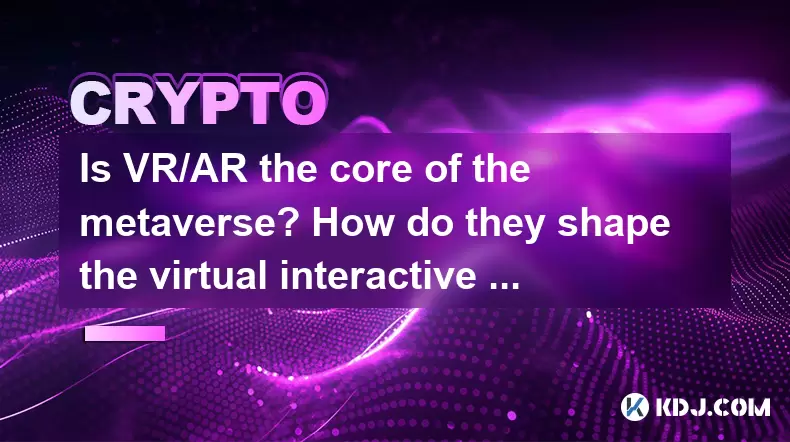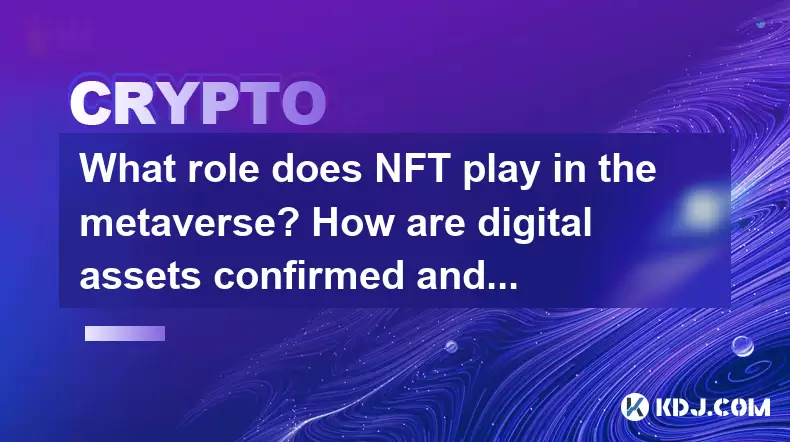-
 bitcoin
bitcoin $95203.028270 USD
-4.12% -
 ethereum
ethereum $3151.730711 USD
-1.61% -
 tether
tether $0.999170 USD
-0.04% -
 xrp
xrp $2.273039 USD
-1.55% -
 bnb
bnb $924.288432 USD
0.14% -
 solana
solana $141.112899 USD
-2.02% -
 usd-coin
usd-coin $0.999964 USD
0.02% -
 tron
tron $0.293976 USD
0.82% -
 dogecoin
dogecoin $0.160772 USD
-1.84% -
 cardano
cardano $0.506357 USD
-3.90% -
 hyperliquid
hyperliquid $37.900515 USD
0.03% -
 zcash
zcash $644.358451 USD
26.66% -
 chainlink
chainlink $14.062007 USD
-2.60% -
 bitcoin-cash
bitcoin-cash $484.381072 USD
-5.12% -
 unus-sed-leo
unus-sed-leo $9.199874 USD
0.27%
Is VR/AR the core of the metaverse? How do they shape the virtual interactive experience?
VR and AR are central to the metaverse, enhancing user interaction by creating immersive environments and blending virtual elements with the real world.
May 11, 2025 at 02:15 pm

The concept of the metaverse has become increasingly popular within the cryptocurrency circle, often intertwined with discussions about virtual reality (VR) and augmented reality (AR). Many enthusiasts and developers believe that VR and AR are indeed at the core of the metaverse, serving as the primary technologies that shape the virtual interactive experience. This article delves into how VR and AR contribute to the metaverse and enhance user interaction within these digital realms.
The Role of VR in the Metaverse
Virtual Reality (VR) is a technology that immerses users in a completely digital environment, often through the use of specialized headsets. In the context of the metaverse, VR plays a crucial role in creating a fully immersive experience. Users can enter virtual worlds where they can interact with other users and digital objects as if they were physically present.
Immersive Environments: VR allows users to step into detailed, three-dimensional worlds. For instance, in a metaverse platform like Decentraland, users can explore virtual lands, attend events, and engage in activities using VR headsets, which provide a sense of presence that traditional screens cannot match.
Enhanced Interaction: With VR, interactions within the metaverse become more natural and intuitive. Users can use hand gestures, voice commands, and even full-body movements to navigate and interact with the virtual environment. This level of interaction is particularly valuable in applications like virtual meetings or gaming, where physical presence enhances the experience.
Personalization and Customization: VR also allows for a high degree of personalization. Users can customize their avatars, environments, and experiences to suit their preferences, making the metaverse a more engaging and personal space.
The Role of AR in the Metaverse
Augmented Reality (AR) complements VR by overlaying digital information onto the real world. In the metaverse, AR enhances the user experience by blending virtual elements with the physical environment. This technology is particularly useful for applications that require a seamless transition between the real and virtual worlds.
Real-World Integration: AR can be used to bring elements of the metaverse into the user's physical space. For example, a user might use an AR app to view virtual art installations in their living room or see real-time data overlays while exploring a virtual marketplace.
Enhanced Accessibility: Unlike VR, which often requires specialized equipment, AR can be accessed through smartphones and tablets, making it more accessible to a broader audience. This accessibility is crucial for the widespread adoption of the metaverse, as it allows more people to participate without the need for expensive hardware.
Interactive Learning and Training: AR is particularly effective for educational and training purposes within the metaverse. Users can interact with virtual models and simulations in their real-world environment, making learning more engaging and effective.
How VR and AR Shape the Virtual Interactive Experience
Both VR and AR significantly enhance the interactive experience within the metaverse by providing users with more immersive and engaging ways to interact with digital content. The combination of these technologies creates a more dynamic and interactive virtual world.
Social Interaction: VR and AR enable more natural and engaging social interactions within the metaverse. Users can meet, communicate, and collaborate in virtual spaces that feel more like real-world environments. This is particularly important for social platforms and virtual events, where the sense of presence can enhance the user experience.
Gaming and Entertainment: In the realm of gaming and entertainment, VR and AR offer unparalleled experiences. VR can transport players into fully immersive game worlds, while AR can bring game elements into the player's real-world environment. Both technologies enhance the interactivity and engagement of games, making them more appealing to users.
Economic Activities: The metaverse is not just a place for social and entertainment activities; it also hosts various economic activities. VR and AR can enhance these activities by providing more realistic and interactive ways to buy, sell, and trade virtual goods. For example, users can use VR to visit virtual stores and try on digital clothing, or use AR to see how a virtual item would look in their real-world space.
Technical Considerations for VR and AR in the Metaverse
Implementing VR and AR in the metaverse requires careful consideration of technical aspects to ensure a seamless and high-quality user experience. Key technical considerations include hardware requirements, network infrastructure, and software development.
Hardware Requirements: VR and AR technologies require specific hardware to function effectively. VR headsets, motion controllers, and high-performance computers are necessary for a fully immersive VR experience. AR, on the other hand, can be accessed through smartphones and tablets, but more advanced AR experiences may require specialized glasses or headsets.
Network Infrastructure: The metaverse relies heavily on robust network infrastructure to support real-time interactions and data streaming. High-speed internet connections and low-latency networks are essential for ensuring that VR and AR experiences are smooth and uninterrupted.
Software Development: Developing VR and AR applications for the metaverse requires specialized skills and tools. Developers must create software that can handle the complexities of 3D environments, real-time rendering, and user interactions. Additionally, they must ensure that the software is compatible with various hardware devices and platforms.
Challenges and Opportunities
While VR and AR offer significant benefits for the metaverse, they also present certain challenges. Addressing these challenges is crucial for the continued growth and development of the metaverse.
User Comfort and Accessibility: VR headsets can cause discomfort and motion sickness for some users, which can limit their adoption. Additionally, the cost of VR and AR hardware can be a barrier to entry for many users. Developers must work to improve user comfort and reduce costs to make these technologies more accessible.
Privacy and Security: As users spend more time in the metaverse, concerns about privacy and security become more pressing. VR and AR technologies collect a significant amount of data about user movements and interactions, which must be protected to prevent misuse. Developers must implement robust security measures to safeguard user data and ensure privacy.
Content Creation and Monetization: The success of the metaverse depends on the availability of high-quality content. VR and AR technologies enable new forms of content creation, but they also require new monetization models. Developers must find ways to create and monetize content that is engaging and valuable to users.
Frequently Asked Questions
Q: Can VR and AR be used together in the metaverse?A: Yes, VR and AR can be used together to create a more comprehensive and immersive experience in the metaverse. For example, a user might use VR to enter a fully immersive virtual world and then use AR to bring elements of that world into their real-world environment.
Q: How do VR and AR affect the social dynamics within the metaverse?A: VR and AR enhance social dynamics by making interactions more natural and engaging. Users can communicate and collaborate in virtual spaces that feel more like real-world environments, which can lead to stronger social connections and more meaningful interactions.
Q: What are the potential applications of VR and AR in the metaverse beyond gaming and entertainment?A: Beyond gaming and entertainment, VR and AR have potential applications in education, training, healthcare, and commerce. For example, VR can be used for immersive educational experiences, while AR can enhance remote training and medical consultations by overlaying digital information onto the real world.
Q: How can developers ensure that VR and AR experiences in the metaverse are accessible to a wide audience?A: Developers can ensure accessibility by focusing on user comfort, reducing hardware costs, and creating content that can be experienced through a variety of devices. Additionally, they can implement features like adjustable settings for VR comfort and provide alternative ways to experience content for users without specialized hardware.
Disclaimer:info@kdj.com
The information provided is not trading advice. kdj.com does not assume any responsibility for any investments made based on the information provided in this article. Cryptocurrencies are highly volatile and it is highly recommended that you invest with caution after thorough research!
If you believe that the content used on this website infringes your copyright, please contact us immediately (info@kdj.com) and we will delete it promptly.
- Aave, Stablecoins, and MiCA Approval: A New Era for DeFi in Europe
- 2025-11-16 07:15:01
- Starknet's STRK Token Defies Market Bleed: TVL Soars Amidst Altcoin Rotation
- 2025-11-16 07:10:01
- TGL Stock, Blockchain & UNIRWA Token: A New York Minute on the Latest Buzz
- 2025-11-16 07:10:01
- BGIN Blockchain's Wild Ride: Unaudited Reports Reveal Strategic Shift
- 2025-11-16 07:05:01
- Bitcoin Price Drop: Decoding the Factors Driving the Dip
- 2025-11-16 07:05:01
- Crypto Rollercoaster: Bitcoin's Dip, Cardano's Rise, and the AI Wildcard
- 2025-11-16 07:00:02
Related knowledge

What role does NFT play in the metaverse? How are digital assets confirmed and circulated?
May 08,2025 at 01:56pm
The integration of Non-Fungible Tokens (NFTs) into the metaverse has revolutionized the way digital assets are owned, confirmed, and circulated within...

How does cloud computing support the metaverse? Can distributed computing power meet huge demands?
May 08,2025 at 05:15pm
Cloud computing plays a pivotal role in supporting the metaverse, a virtual reality space where users can interact with a computer-generated environme...

What is the connection between digital twins and the metaverse? How is the physical world mapped to the virtual space?
May 08,2025 at 05:43am
The concept of digital twins and the metaverse has become increasingly intertwined within the cryptocurrency and blockchain community, as both technol...

Is VR/AR the core of the metaverse? How do they shape the virtual interactive experience?
May 11,2025 at 02:15pm
The concept of the metaverse has become increasingly popular within the cryptocurrency circle, often intertwined with discussions about virtual realit...

How does 5G promote the development of the metaverse? How important is high-speed network for immersive experience?
May 08,2025 at 04:21am
The relationship between 5G technology and the development of the metaverse is intricate and pivotal. 5G, with its high-speed, low-latency, and high-c...

What AI technologies does the metaverse need? What role does machine learning play in virtual environments?
May 08,2025 at 06:08am
The metaverse, a collective virtual shared space, relies heavily on advanced AI technologies to create immersive and interactive environments. AI tech...

What role does NFT play in the metaverse? How are digital assets confirmed and circulated?
May 08,2025 at 01:56pm
The integration of Non-Fungible Tokens (NFTs) into the metaverse has revolutionized the way digital assets are owned, confirmed, and circulated within...

How does cloud computing support the metaverse? Can distributed computing power meet huge demands?
May 08,2025 at 05:15pm
Cloud computing plays a pivotal role in supporting the metaverse, a virtual reality space where users can interact with a computer-generated environme...

What is the connection between digital twins and the metaverse? How is the physical world mapped to the virtual space?
May 08,2025 at 05:43am
The concept of digital twins and the metaverse has become increasingly intertwined within the cryptocurrency and blockchain community, as both technol...

Is VR/AR the core of the metaverse? How do they shape the virtual interactive experience?
May 11,2025 at 02:15pm
The concept of the metaverse has become increasingly popular within the cryptocurrency circle, often intertwined with discussions about virtual realit...

How does 5G promote the development of the metaverse? How important is high-speed network for immersive experience?
May 08,2025 at 04:21am
The relationship between 5G technology and the development of the metaverse is intricate and pivotal. 5G, with its high-speed, low-latency, and high-c...

What AI technologies does the metaverse need? What role does machine learning play in virtual environments?
May 08,2025 at 06:08am
The metaverse, a collective virtual shared space, relies heavily on advanced AI technologies to create immersive and interactive environments. AI tech...
See all articles









































































